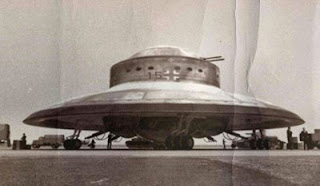Let's re-enter the lost world with another installment of my issue by issue examination of DC Comic's Warlord
, the earlier installments of which can be found here...
"The Prophecy: Chapter 3: Return of the Sea-Eagles"
Warlord Annual #2 (1983)
Written by Cary Burkett; Penciled by Dan Jurgens; Inked by Mike DeCarlo
Synopsis: Pulled down into the depths, Morgan is close to drowning when he finds an underground grotto. After a rest, he follows the glowing lights into a passage he hopes will lead him out. Only a short distance down the passage, he finds the way blocked by a rock pile.
Climbing the pile, Morgan manages to squeeze through a narrow space at the top. He tumbles into darkness. Somehow, he triggers a switch, and his surroundings are suddenly brightly lit:
He finds a bag of grenades and silver cassettes with a swan emblem on them. He throws one of those into the bag to take to Krystovar. Most importantly, he finds a swan-prowed sky-sled that seems similar to one he flew before. And it’s armed with a laser weapon.
Morgan flies out of the hangar. He follows an underground stream back to the sea passage, but has to use the laser to blast his way through the last bit. He flies on toward New Atlantis to rescue his friend.
Meanwhile, the Brood-Brothers bring Krystovar before their prince, Ar-Pharazael. Krystovar has been a thorn in the prince’s side for some time, but now he’s captive, and the scrolls of Norrad he had stolen are returned. There’s just one thing:
The helmet whose return is prophesized to herald the end of New Atlantis.
Ar-Pharazael flies into a rage. He orders the Beast-Changer(
tm) prepared to give Krystovar the head of a roach!
Over New Atlantis, Morgan sees the ship he had been held captive on. He drops in to retrieve his pistol from the boar-headed captive and get some information.
In the city, Ar-Pharazael has Krystovar strapped into the Beast-Changer. He boasts he has no fear of fairy-tales and plans to have the eagle helm melted down. At that moment, Morgan makes his attack. He drives the crowd back with the laser, then tries to destroy the jewel powering the Beast-Changer, but for some reason it’s resistant.
With no other choice, he sends the sled crashing into the machine. Morgan moves to free Krystovar. His ammo running low, he throws one of the grenades into the advancing beast-men—and is surprised when it totally disintegrates them.
Krystovar finds Ar-Pharazael half-buried and likely dying beneath some debris from the machine. He asked the prince what became of his brother. Ar-Pharazael tells him his brother lives—but he’s been turned into one of the Brood-Brothers! He dies before Krystovar can get more out of him.
Morgan and Krystovar make their escape. Morgan uses the grenades to eliminate their pursuers. At the docks, they steal a boat. They set sail for the cave passage.
Things to Notice:
- Krystovar gets called "Krystobal" and "Krystobar" in this issue.
- Is New Atlantis underground or not? Earily issues suggested it was, but it certainly seems to have a brightly lit sky. Is it under Skartaris's eternal sun?
Where it Comes From:
Morgan makes reference to the controls of the sky sled resembling "the Atlantean sled I flew once before." Either Morgan is misremembering, or this is an undepicted adventure. He flew a sled of the alien Alces Shirasi in issue #18, and a flying disc taken from the Titans in issue #33, but neither particularly resembled this one nor could they be identified as "Atlantean."
Ar-Pharazael swears by Astoreth in this issue, which is the name given in the Hebrew Bible to a goddess of the Phoenicians, often called
Astarte. In later demonology, she gets transformed into Astaroth, a male devil. Ar-Pharazael's own name seems to evoke "Pharoah" and "Azazel" (a supernatural being mentioned in the Bible, which later folklore identifies as a devil).
























